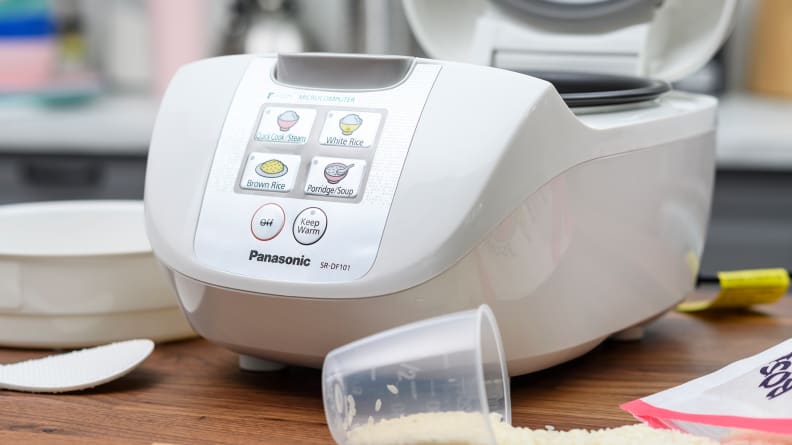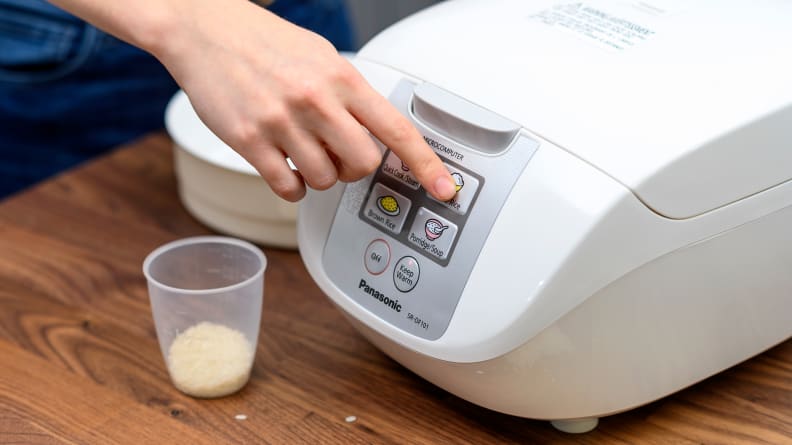How to use a rice cooker to cook every type of rice
Trust us, it’s better than an Instant Pot.
 Credit:
Reviewed / Jackson Ruckar
Credit:
Reviewed / Jackson Ruckar
Recommendations are independently chosen by Reviewed's editors. Purchases made through the links below may earn us and our publishing partners a commission. Prices were accurate at the time this article was published but may change over time.
In Asian households, there’s a running joke that we cook rice before we even know what’s for dinner. If you’re like us, you can’t get enough of it—and you’ll never turn down an easier way to prepare it. For those who are trying out home-cooked meals to stay healthy during the quarantine, managing side dishes like rice can be daunting. While meal kits subscription services can take some stress out of planning, multitasking in the kitchen and not burning at least one component can be a true feat.
Enter: the rice cooker, a kitchen essential that cooks perfectly fluffy rice every time—you just can’t get the same results with the stovetop method. And since rice is a universal side dish that pairs well with pretty much all your favorite foods (think: chicken, beef, tofu, and more), mastering this appliance will make mealtime a whole lot easier.
What is a rice cooker?

No other kitchen gadget knows your rice better than a rice cooker.
Think of your rice cooker as a rice specialist, compared to the multi-purpose Instant Pot with one million functions. We love how our favorite electric multicooker can handle the most exhausting (but rewarding) weeknight cooking tasks, but a decent rice cooker has a serious edge when it comes to steaming the fluffiest, most aromatic brown rice and quinoa—the Instant Pot simply can’t compete.
Like multicookers, rice cookers use tight seals to allow water boil in an enclosed space. They have built-in temperature gauges to alert you as soon as the rice is ready, typically once the cooker hits 212℉. Our favorite rice cooker, the Zojirushi Neuro is equipped with “fuzzy logic,” which means there’s a computer chip inside the cooker that monitors and adjusts the cooking parameters in case of human errors potentially impacting the results—especially when first-time users add too little or too much water. The fuzzy logic feature is popular among advanced rice cookers, as it guarantees the same quality of rice every time.
How to use a rice cooker

A rice cooker helps you cook the best rice, regardless of the water-to-rice ratios.
Different types of rice require specific water-to-rice ratios and cooking times. Additionally, your rice cooker may come with unique features, such as automatic timers, warming controls, or settings for different types of rice. For this reason, we recommend reading the gadget’s manual before diving in.
However, to get you started, we've outlined the general steps for cooking medium grain white rice below. Seriously, it's so easy you'll wonder why you waited so long to invest in a rice maker!
Step 1: Rinse rice
Pour 1 cup of rice into a sifter, then run it under cold water. Rinse the rice under water at least three times to remove dirt and excess starch, which prevents the rice from clumping together and getting gummy while cooking. The general rule is to rinse the rice until the water is clear. You'll only need to rinse the rice before cooking.
Step 2: Combine rice and water
Open the top of your rice cooker and add the rice and 1-1/2 cups of water directly into the pot. Lightly shake the pot a little to create an even surface for heating.
Step 3: Set it and forget it
Set your cooker to the appropriate setting, then turn it on. White rice will cook in about 20 to 25 minutes. Your rice cooker will automatically switch to the warming setting when the rice is done.
Step 4: Fluff and serve
When the rice is done, open the lid and use a rice spatula or wooden spatula to stir up the rice. This step allows the rice to steam and the water vapor to escape. After stirring, close the lid and let any excess steam absorb back into the rice for optimal fluff.
Finally, remove your rice from the cooker and serve it with something delicious. Or eat it on its own—it's your life!
- 1 cup uncooked white rice
- 1-1/2 cup water
- A sifter

You can make brown rice, quinoa, and risotto in a rice cooker!
If you’re a rice enthusiast, you know that no two grains are made equal. The steps above are for white, medium-grain rice, but if you find yourself craving one of the following varieties, tweak the steps as indicated.
Brown rice
As its name suggests, brown rice is, well, brown. This whole-grain variety has significantly more fiber and nutrients than white rice, making it a popular choice for those striving to eat healthier. If you’re still on the fence about getting a rice cooker, you won’t regret it—it cooks the best brown rice.
- Ratio: 2 cups water to 1 cup rice
- Cook time: 25–30 minutes
- Additional directions: If you enjoy the nuttier flavor of brown rice, we recommend an additional step between 1 and 2: toasting. After rinsing the brown rice, heat a tablespoon of olive oil over medium heat, then add the uncooked rice. Toast it for about 1 to 2 minutes, stirring constantly, until you smell a nutty aroma. Add your toasted rice to the cooker with water, starting at step 3.
Quinoa
Packed with fiber and low in carbohydrates, quinoa is a favorite of health-conscious foodies. It’s gluten-free and mixes well with spices, butter, and your favorite diced vegetables—just like rice.
- Ratio: 2 cups water to 1 cup quinoa
- Cook time: 15 minutes
- Directions: Follow the directions for white rice outlined above.
Jasmine rice
This long-grain rice is perfect for pairing with stir fry and soup. Jasmine rice cooks more quickly than conventional white rice, and it pairs well with heavy, saucy dishes. It’s less soft compared to medium grain white rice, but its dryness makes it perfect for fried rice.
- Ratio: 1-3/4 cups water to 1 cup rice
- Cook time: 15 minutes
- Directions: Follow the directions for white rice outlined above.
Sushi rice
Surprise, surprise, this short-grain, vinegary white rice is for making sushi, as it easily clings to the rolling mat during rolling. In Japan, it’s known as Japanese rice, and fun fact—it’s also used to make sake! (But please don’t do that in your rice cooker.)
- Ratio: 1 cup water to 1 cup rice
- Cook time: 15 minutes
- Additional directions: Follow the steps outlined above until you hit step 6. Let the rice rest as noted, but while it’s resting, combine 1 Tbsp. rice vinegar, 1 Tbsp. sugar, and 1/2 tsp. salt in a small bowl, then heat in the microwave for 30 seconds. Transfer the cooked rice to a large bowl, combine with the vinegar mixture, then allow it to come to room temperature before rolling sushi.
Basmati rice
Popular in South Asian cuisine, the special seasoning in Basmati rice gives it a distinctive aroma and flavor. This long-grain rice cooks quickly and pairs well with heavy dishes such as lentil soup and curry.
- Ratio: 1 3/4 cups water to 1 cup rice
- Cook time: 15 minutes
- Additional directions: Follow the directions for white rice outlined above and serve with ghee.
Sweet rice
Also known as glutinous rice, sticky rice is the token base ingredient in many famous dessert dishes in Asian cuisines. You can purchase glutinous sweet rice at your local grocery store or on Amazon. It clumps together easily, meaning you can shovel more into your mouth without flicking pieces around.
- Ratio: 1-3/4 cups water to 1 cup rice
- Cook time: 2 hours and 15 minutes
- Additional directions: Instead of rinsing your rice in step 1, combine water and rice in a large bowl and allow it to soak for 2 hours. Sticky rice needs to be pre-softened before steaming. After the time has passed, pour the mixture into your rice cooker and start back up at step 3.
Risotto
Thanks to the nonstick material that’s designed to keep ingredients from burning, a rice cooker can make the delicious Italian dish without requiring all the labor of stirring.
- Ratio: 3 cups chicken stock to 1 cup arborio rice
- Cook time: 45 minutes
- Additional directions: Place 1 cup arborio rice in the rice cooker and pour in the chicken stock. Lightly stir to create an even surface. Close the lid and let it cook for one cycle, then give it an additional 10 minutes to fully absorb the liquid before opening the lid. Then sprinkle the risotto with grated parmesan cheese and it’s ready to serve!
How to clean a rice cooker

Use soft tools to clean the pan because most pans have nonstick coating.
After you’ve enjoyed every morsel of your perfectly cooked rice, it’s time to lovingly clean your rice cooker and put it away for the next time.
First, unplug the rice cooker. Allow it to come to room temperature before cleaning it—running the pan underwater while it’s still hot can warp the pan insert. Remove the inner pan and lid so you can wash them both. The inner lid protects the heating element from picking up dirt in the air, so it’s crucial to keep it clean at all times.
To keep the inner pan clean, brush off any remaining dried pieces of rice and then clean it with warm, soapy water. Always use a wooden spatula for your rice cooker—most of the inner pans are nonstick and damaged by metal utensils.
If the pot doesn't have a removable insert, simply use a sponge to wipe it down. Let it dry, then put it away until next time.
Happy steaming!

A rice cooker can be your kitchen best friend.






